

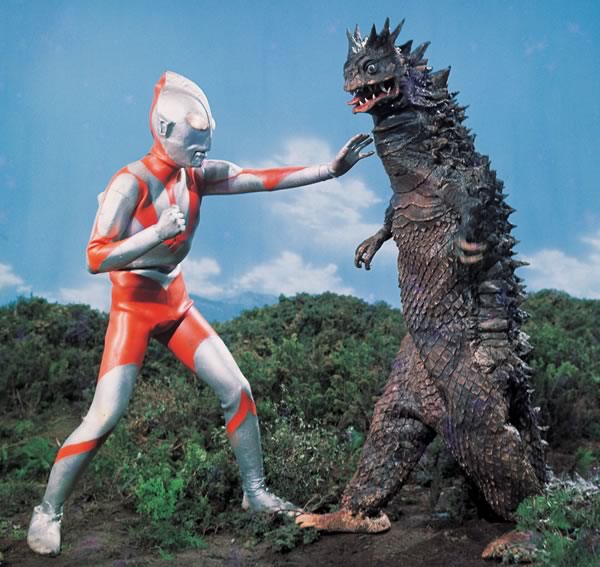
Ultraman is possibly the most influential series in the tokusatsu genre. Just about every piece of Japanese media has referenced it at least once, and plenty of American and western films and shows have borrowed iconography or shots from it. That’s not to say the show hasn’t taken its own fair share of influence from elsewhere, but that its particular iterations of these concepts and ideas were made here. Modern science fiction films, games, and comics, especially of the sort that sees “science” as a setting or tone more than as an assignment, owes quite a lot to the interstellar and interdimensional invaders that have appeared throughout this series.
Given its proliferation throughout modern media, I thought it’d be a good idea to watch through the original series from start to finish, possibly moving to Ultraseven and the later shows afterwards, to see the various tropes and memes that we enjoy today develop and flourish right at their source. While the series technically started with Ultra Q, the titular Ultraman himself wouldn’t appear until this series in 1966, so that’s where I’m starting.
I’m writing largely on-the-fly here, giving first impressions and a basic synopsis of each episode and attempting analysis with whatever info I’ve got on me at the moment. I’m afraid I have very little in way of cultural commentary or behind the scenes info at the moment. I’m trying to tackle this show one episode at a time, and I apologize in advance if I get a plot point or arc wrong. I’m also apologizing in advance if I get a bit too carried away with my analysis of this or that camera angle, or discussions on such vagaries like the ever-popular discussions of “theme” that fill the web today.
/ So, episode one!
This one is titled “ULTRA OPERATION NO. 1,” which might seem a little plain as far as titles go, but it sets a kind of important tone for this sequel to Ultra Q. Speaking of Ultra Q, the title splash we get for it is a favorite of mine. The swirling psychedelic paint seemingly bending itself backwards into the title set to a bizzare cacophonic sound sets the tone as alien, unnerving, and cool.
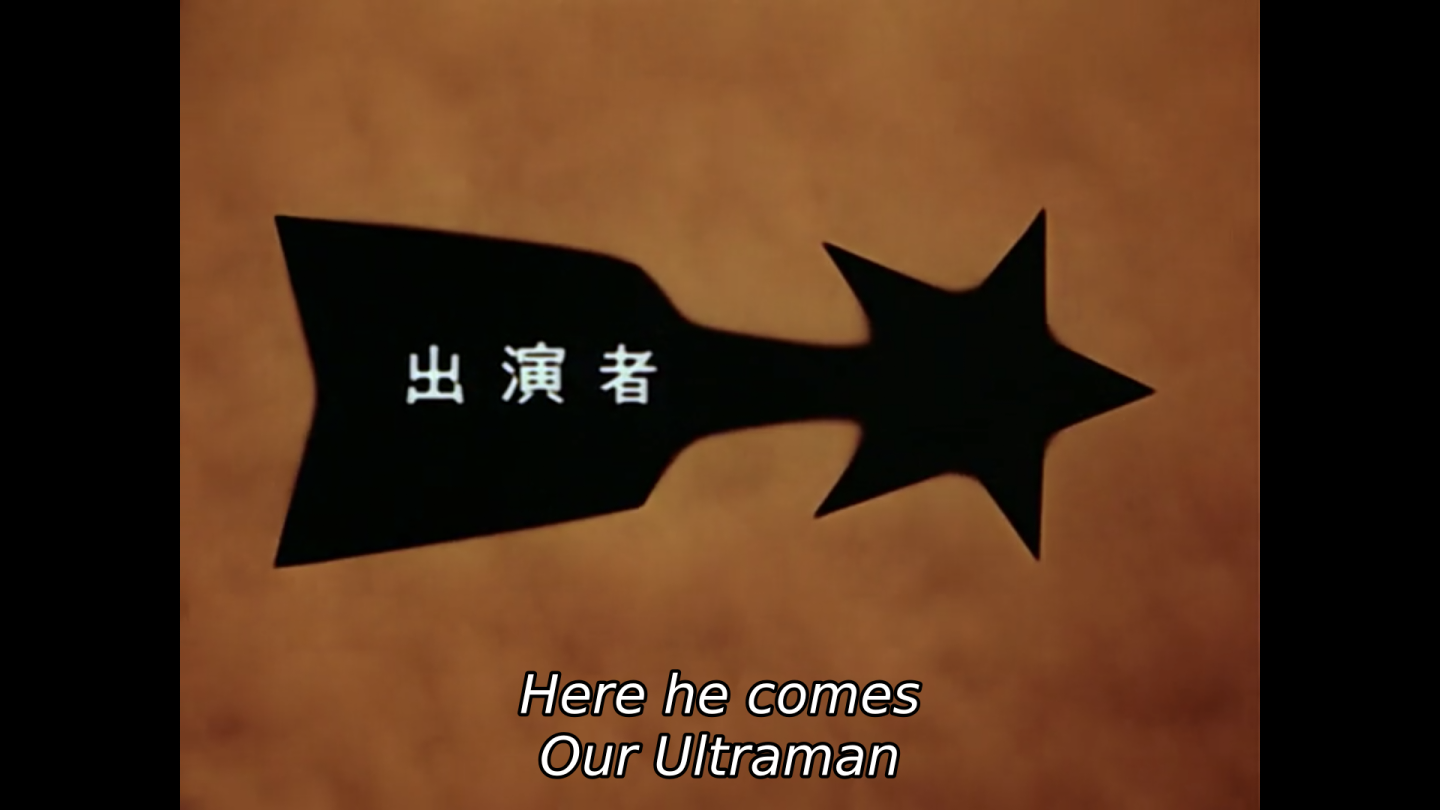
I’m taking the time to talk about the titles and splashes here because they’ll be especially relevant to the conclusion of this episode. The theme song and opening credits feature shadow puppets of Ultraman and various monsters backed by a colored light. It’s a cool tribute to classical modes of Japanese storytelling, like kamishibai, which prominently featured stories of super-powered heroes defeating alien or monstrous invaders.
The shooting star that appears is of especial importance here. It’s accompanied by the lyric “Here he comes, Our Ultraman!” alongside fantastic boasts of the hero’s power, and the assertion that he comes “from the land of light.” I won’t tell you what I think it means just yet, I want you to do that on your own really quick and file it away for later. The last slide tells us that this episode features the “Space Monster Bemular,” because monsters deserve credits too.
Then the show actually starts, with my favorite kind of opening shot, space! A strange red sphere is chasing an equally strange blue sphere before a snazzy spaceplane flies by.
There’s a tendency in this show for objects to enter from the right side of the screen and move to the left, to accommodate a natural reading motion. Most western media does the reverse of this; it’s the reason why western comics are read from left to right and how manga is read from right to left.
The miniatures are well-made, if quite obvious. The little jets in the spaceplane are cool. It’s a good thing I don’t have access to one.
After the first cut from the spaceplane, our narrator informs us that our heroes are the Japanese branch of the Paris-based International Science Police Organization, a group of five known as the Science Special Search Party, or SSSP. It’s worth mentioning that the organization isn’t home-grown per se, but a limb of an international effort. Either this was chosen to allow the SSSP a degree of independence from the Japanese government, or to make a larger point about our heroes’ mission. I’m sure we’ll find out one way or the other soon enough.
At any rate, the SSSP is supposed to deal with things that we can’t quite understand just yet, whether these are “anomalies” or invaders from outer space.
Our pilot this episode is Shin Hayata, and we catch him radioing in to HQ as soon as he spots the two space marbles’ quarrel. Interestingly, Hayata refers to himself as just “Hayata,” with no title or honorific. Maybe he’s just being humble.
Back at base, the SSSP’s communications officer, Akiko Fuji, answers Hayata. We’ll get back to her in just a second.
I want to talk about the establishing shots of HQ here. Akiko is seated in front of a large computer bank, and in the subsequent shot we can see the SSSP has a large plexiglass map, allowing the camera to sneak behind it for a dynamic, wide view of a relatively small space. It kinda feels like a cleaner, more professional version of the rebel base from Star Wars in here. Even though there’s only four members on call here it seems quite busy.
We cut back to Akiko so that the SSSP’s resident bossman, Cap, can take the mic from her. You can tell he’s in charge because he has a pipe and he carries himself with a rather important demeanor, all serious glances and stern gazes. Cap tells Akiko to start recording everything Hayata says.
/ This will become a significant focal point in just a bit.
She circles back to a central desk and deploys a tape recorder. There’s a line of space-age helmets on this desk. The camera sits close, giving impressive weight to them. The prominent visors, antennae, and science-investigator motif must have surely inspired Science Ninja Team Gatchaman later on down the line.
Where was I? Oh, the tape recorder.
Akiko starts the recording with a big chunky analog button, and the tape recorder itself pops out of the desk just behind a large scrap book. Having the two of them together seems rather significant.
We have memories that have been made, perhaps some time ago, and memories that are actively being made, right now. The chronicle of a lifetime, now being actively written, or well, recorded. Hayata announces he’s going to investigate these spheres, which are moving at a brisk mach 2. It’s not all that fast as far as space travel is concerned, but it sounds cool, and it lets lesser Earth jets compete.
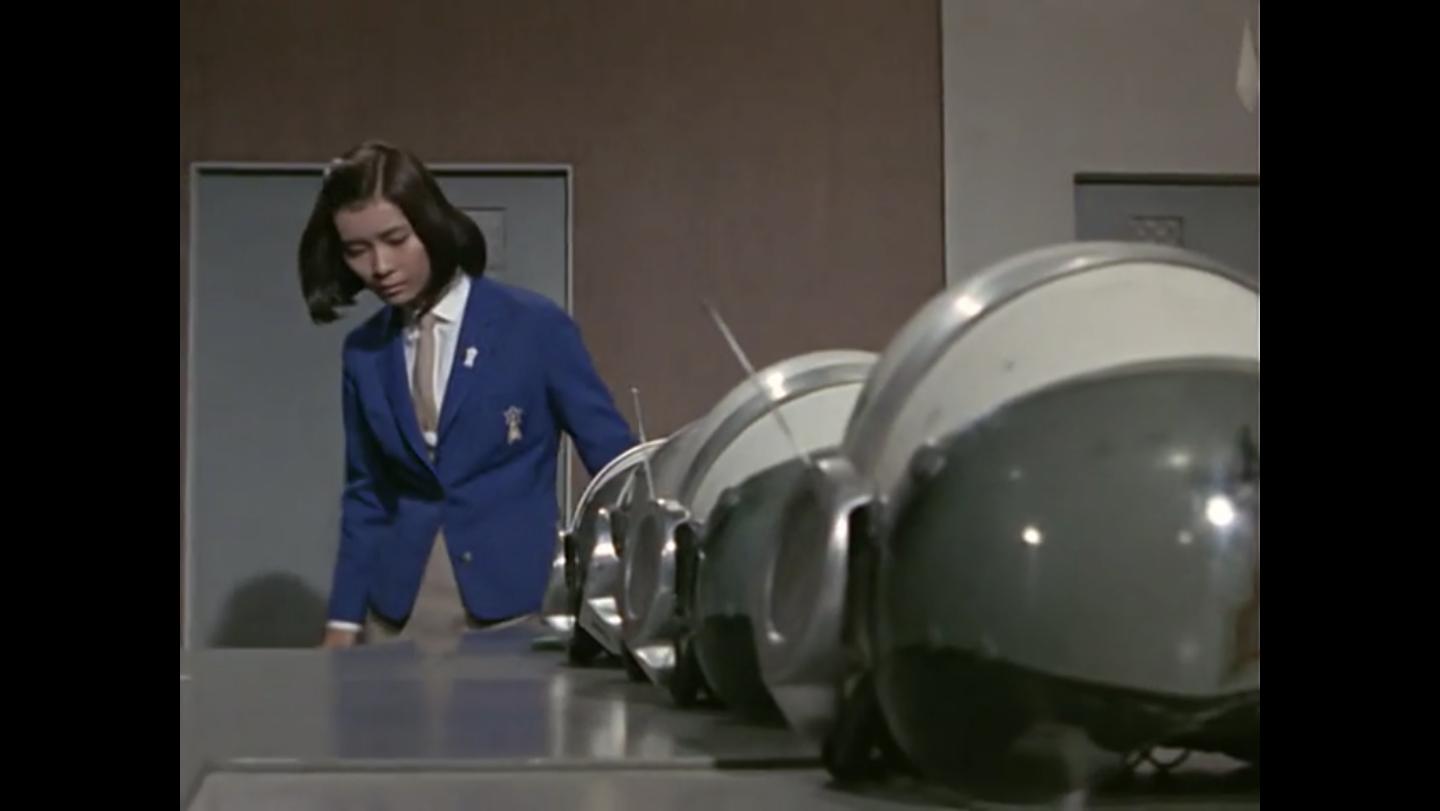
Cut to Earth. A bunch of youngsters are out camping by the lake. I unfortunately do not know the song they’re singing, or else I’d probably have a whole diatribe ready to go about its symbolic significance.
We get a cool layering shot as the blue sphere sinks into the lake. Sure the models and miniatures might seem a bit dated by today’s standards, but their craftsmanship is quite impressive. The blue sphere even casts light onto the lake as it descends, lending credence to the plausible reality that it might actually be there, and not you know, between a small pool and a miniature set.
There’s no LED in the sphere, by the way. Early visible-light LEDs only emitted red light and were in limited supply until the 70s. While I’m sure both you and I can figure out how they managed to get the ball underwater, I’m still kinda baffled as to how it’s being lit.
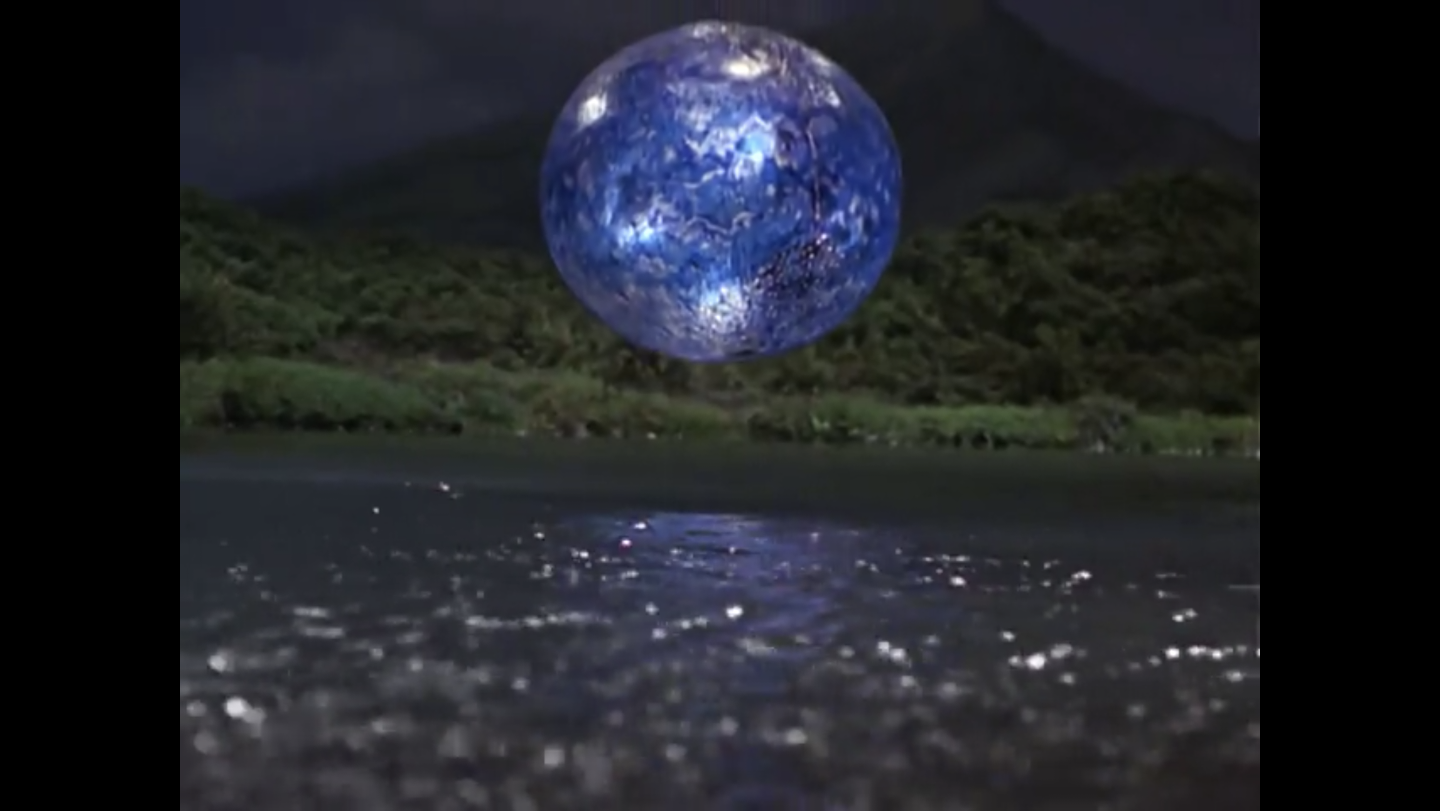
The ball submerges and the water boils, to the befuddlement of the campers. The red sphere follows soon after and crashes into Hayata’s spaceplane. There’s a pretty healthy gout of flame that comes up as he goes down, and the first time I saw this I actually said “oh, he’s dead” aloud.
Back at SSSP HQ, the police have been called and are reporting the incident to the SSSP. Nice of the campers to call in an alien sighting like that, then again I suppose we do that in the states too. We get the first big dramatic zoom in the show, straight in to Cap’s face as he removes his pipe from his mouth, hints of terror starting to form in his stoic visage.
There are a number of great panning shots as we’re taking all this in, giving wide sweeps of each scene. I mean “taking all this in” both in a literal and emotional sense. Hayata’s sudden apparent demise kinda begs for investigation. The police officer on the radio is going to show up a few more times in this episode, and he’s positively shell-shocked by what he’s seen.
Cap hopes Hayata isn’t hurt, and Akiko tries to hail him on the radio. She refers to him as “Hayata Tai’i,” which typically would be translated to “Captain Hayata,” even though it isn’t the exact equivalent of captain – or else why would they refer to their boss as Cap?
Speaking of Cap, he orders the SSSP to deploy and a series of rapid shots shows the gang are wearing uniforms under their suits the whole time! It’s hard not to feel like you’re watching a bit from classic Batman here, especially as the VTOL blasts off.
I suppose I should talk a bit more about these uniforms, as I’ve seen stuff like this elsewhere. The bright orange coveralls are a prominent feature of disaster response teams in Japanese media, but the SSSP pair that with a snappy white tie and blue undershirt. It looks both formal and practical in a rather absurd way, but it isn’t so loud and obnoxious that it feels particularly out of place in the setting. I’d call it “camp,” but it isn’t the same kind of camp as the aforementioned Batman. It’s business practical, perhaps? One dash Devo and another of the Blues Brothers. A spacesuit with a tie.
We cut from the blazing engines to Hayata’s burning spaceplane. Hayata’s body is levitated in the air and surrounded by the red sphere from earlier, leading to the first appearance of the main man himself, Ultraman!
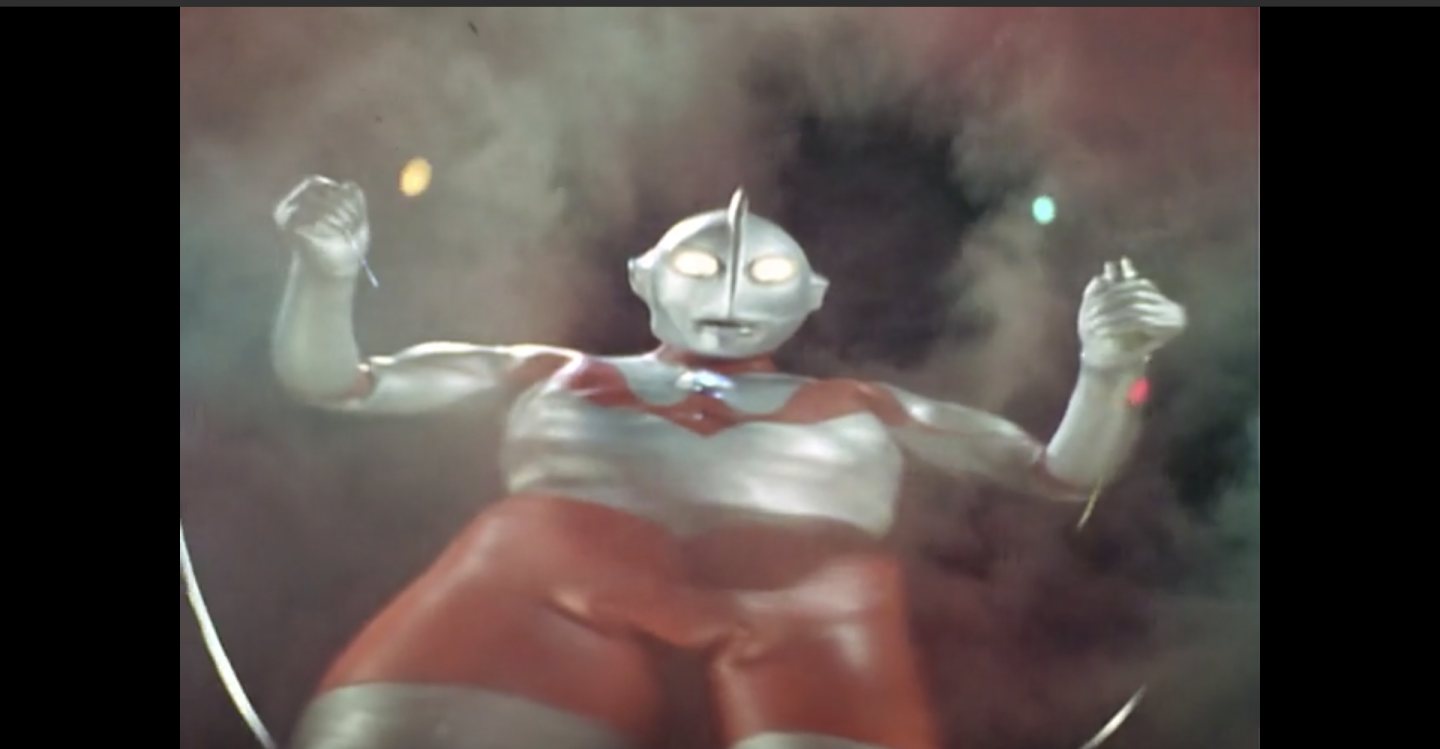
There’s a wonderful series of sights and sounds that lead up to his first appearance, including that weird twisting sound from the Ultra Q splash. The atmosphere is mysterious, dreamlike and surreal, with a lenticular effect and billowing smoke in many colors. When he first appears, Ultraman is clasping his hands together. Perhaps in prayer, perhaps like he’s just poured water or salts on Hayata. The gesture seems significant if only because he spreads them apart before he speaks. There appears to be something in his left hand.
Ultraman introduces himself as “an alien from Nebula M78.” There’s no special titles or anything beyond just that. His voice is filtered and echoes, which can be a bit hard to understand at times, but Hayata’s voice comes in clear as day. I’m guessing the reason for this is that the two of them are speaking inside of Hayata’s own mind, and that Hayata is mentally-sound, because I’d probably go crazy – or crazier – if my inner monologue echoed like it does in most other movies.
Ultraman explains to Hayata that he was going to take Bemular to the Space Graveyard, which sounds like what an alien would say if they actually meant to completely destroy someone and leave them adrift in the cold void of space, but maybe I’m reading too much into that.
Ultraman describes Bemular as a “demon-like monster.” The exact Japanese word used here is “akuma,” which as far as I can tell means he sees the thing as a true devil.
So! To apologize for crashing and possibly killing Hayata, Ultraman tells him that he’s willing to give his life to him. In doing this, they will both become the same entity. He drops an object he calls the Beta Capsule onto Hayata’s chest.
The actor tries really hard not to fidget from the impact of it, but he does just a bit.
Before he can explain what the Beta Capsule’s function is, he laughs creepily and tell Hayata it’ll work in a pinch.
Back to the campers, who are watching the strange red orb. The officer who called the SSSP in is staring slack-jawed at it while the rest try to figure out what’s going on. The orb explodes and before they can get themselves back on their feet, Cap and the rest arrive on the scene. There’s two big zooms, one on the shellshocked policeman and another to the shooting star insignia on Hayata’s crashed jet.
/ Do you have a good idea of what this symbol is supposed to represent yet?
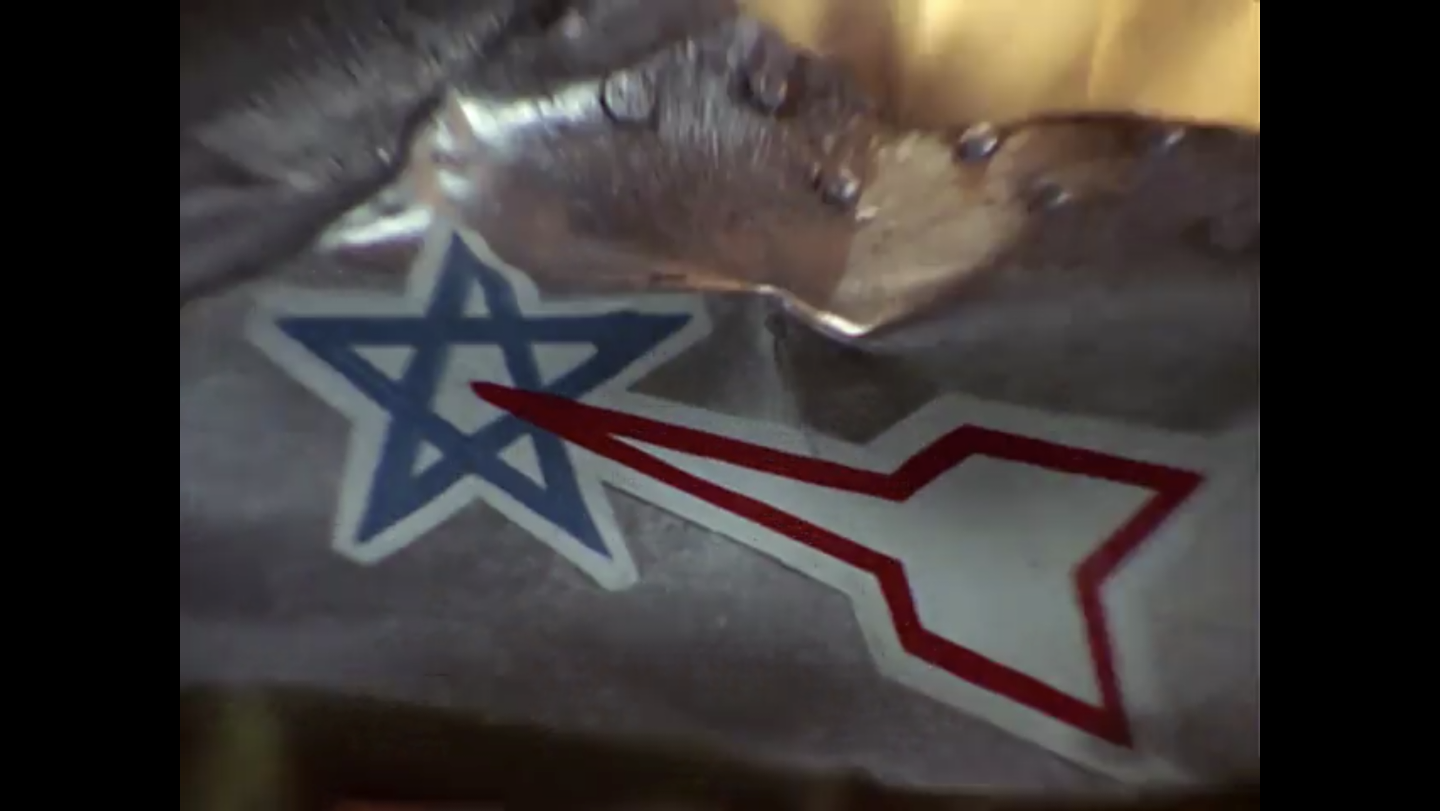
This shot is the nadir of the episode, and we aren’t even at the halfway point yet!
This zoom convinces Ide – the SSSP’s comedic relief – that Hayata is a goner, but the police officer tells them that they saw Hayata’s body levitating up into the sky with a sphere of light. Ide scoffs, “that’s impossible!” The police officer claims that “the impossible happened!” They have a brief, comic misunderstanding over the use of the word “impossible” here, until another officer steps forward and suggests that a possible explanation for the goings-on would be that they witnessed extraterrestrial activity. Cap agrees with a solemn nod.
He knows when to take a man at his word, it seems.
Tune in next time to find out what happens to our hero, Hayata, and find out the meaning behind the mysterious SSSP symbol!
Remember to join our mailing list, comment below, and follow us on social media to keep in touch and see when we post new articles every week! Feel free to share this article to those who you know will enjoy it.
We look forward to seeing you around the Tokusatsu Collect community!